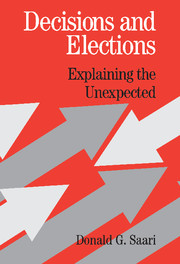Crossref Citations
This Book has been
cited by the following publications. This list is generated based on data provided by Crossref.
Saari, Donald G.
2002.
Adopting a Plurality Vote Perspective.
Mathematics of Operations Research,
Vol. 27,
Issue. 1,
p.
45.
Percus, Ora E.
and
Percus, Jerome K.
2002.
Can Two Wrongs Make a Right? Coin-Tossing Games and Parrondo’s Paradox.
The Mathematical Intelligencer,
Vol. 24,
Issue. 3,
p.
68.
Neubauer, Michael G.
and
Zeitlin, Joel
2003.
Apportionment and the 2000 Election.
The College Mathematics Journal,
Vol. 34,
Issue. 1,
p.
2.
Mackie, Gerry
2003.
Democracy Defended.
Neubauer, Michael G.
and
Zeitlin, Joel
2003.
Outcomes of Presidential Elections and the House
Size.
PS: Political Science & Politics,
Vol. 36,
Issue. 4,
p.
721.
Nureev, R.
2003.
Public Choice Theory. A Textbook. Chapter 7. Public Choice under Representative Democracy: Government and Coalitions in Parliament.
Voprosy Ekonomiki,
p.
111.
Saari, Donald G.
2004.
Geometry of Chaotic and Stable Discussions.
The American Mathematical Monthly,
Vol. 111,
Issue. 5,
p.
377.
Nurmi, Hannu
and
Suojanen, Maria
2004.
Assessing Contestability of Electoral Outcomes.
Quality & Quantity,
Vol. 38,
Issue. 6,
p.
719.
Dowding, Keith
Goodin, Robert E.
and
Pateman, Carole
2004.
Justice and Democracy.
Behnke, Joachim
2004.
Jahrbuch für Handlungs- und Entscheidungstheorie.
p.
155.
Quesada, Antonio
2005.
Abstention as an escape from Arrow's theorem.
Social Choice and Welfare,
Vol. 25,
Issue. 1,
p.
221.
Hastie, Reid
and
Kameda, Tatsuya
2005.
The Robust Beauty of Majority Rules in Group Decisions..
Psychological Review,
Vol. 112,
Issue. 2,
p.
494.
Adamowicz, Wiktor
Hanemann, Michel
Swait, Joffre
Johnson, Reed
Layton, David
Regenwetter, Michel
Reimer, Torsten
and
Sorkin, Robert
2005.
Decision Strategy and Structure in Households: A “Groups” Perspective.
Marketing Letters,
Vol. 16,
Issue. 3-4,
p.
387.
Kher, S.
Somani, A.K.
and
Gupta, R.
2005.
Network selection using fuzzy logic.
p.
876.
Perote-Peña, Juan
and
Piggins, Ashley
2005.
Pareto efficiency with spatial rights.
Journal of Mathematical Economics,
Vol. 41,
Issue. 3,
p.
265.
Igersheim, Herrade
2006.
Le paradoxe libéral-parétien: un second théorème d'impossibilité dû aux “effets d'indépendance”.
Social Science Information,
Vol. 45,
Issue. 4,
p.
501.
Saari, Donald G.
2006.
Mathematics and Democracy.
p.
221.
Frey, Daniel D.
and
Dym, Clive L.
2006.
Validation of design methods: lessons from medicine.
Research in Engineering Design,
Vol. 17,
Issue. 1,
p.
45.
Ratliff, Thomas C.
2006.
Selecting Committees.
Public Choice,
Vol. 126,
Issue. 3-4,
p.
343.
Brams, Steven J.
Hansen, Michael W.
and
Orrison, Michael E.
2006.
Dead Heat: The 2006 Public Choice Society Election.
Public Choice,
Vol. 128,
Issue. 3-4,
p.
361.





